Introduction
The state of Florida has the second highest value of vegetable production in the United States and also one of the largest and most diverse agricultural industries, with over $1.93 billion in cash receipts in 2011 (FDACS 2014). Florida is well known for crop commodities such as citrus, strawberry, tomato, pepper, and watermelon, as well as annual and perennial nursery plants. However, little is known about the value of fresh fruits, vegetables and herbs grown using various types of protected agriculture structures or hydroponic systems and technologies (Hochmuth 2012; Hochmuth and Cantliffe 2012). The most recent protected agriculture acreage surveys were conducted by the University of Florida, Institute of Food and Agricultural Sciences (UF/IFAS) in 1991, 1996, and 2001 (Tyson, Hochmuth and Cantliffe 2013).
During the decade from 1991 to 2001, the fresh fruit and vegetable protected agriculture industry almost exclusively involved greenhouse-grown vegetables and herbs. Acreage reported in the University of Florida surveys indicated greenhouse vegetable and herb acreage was 66, 58, and 95 acres in 1991, 1996, and 2001, respectively. The primary protected agriculture structures used during that period were either fan and pad or passively ventilated greenhouses. Most crops were grown using soilless media such as perlite, rockwool, and peat-based soilless mixes, or other hydroponic systems like nutrient film technique (NFT) (Hochmuth, Hochmuth and Sweat 2012). Vegetable acreage grown during the decade between 1991 and 2001 began to show crop diversification: while tomato, cucumber, and lettuce were more popular in the early part of the decade, acreage of alternative crops such as pepper, fresh herbs, and strawberry began to become much more important by 2001 (Hochmuth and Cantliffe 2012).
Methods
UF/IFAS Extension faculty, allied industry representatives, and growers determined the need to assess the size and scope of the protected agriculture industry in 2013 by surveying growers in Florida (Hochmuth and Hochmuth 2014). The task of developing the survey instrument was much more difficult in 2013 than in previous survey years because the industry had greatly diversified in several categories, including crops being grown, types of protected structures being deployed, and the types of soil-based, soilless, and other hydroponic production systems being implemented. The types of structures to be surveyed were determined to fall in one of the following categories: high tunnels, fan and pad ventilated greenhouses, passively ventilated greenhouses, shade houses, retractable roof structures, and those with no permanent structure or with temporary freeze protection covers (Fenneman et al. 2013; Hochmuth et al. 2012; Hochmuth et al., 2013; Santos Vallad and Torres-Quezada 2013a). Production systems were determined to fall into one of the following categories: native soil, amended native soil, NFT, floating systems, lay-flat bags filled with soilless media, upright containers filled with soilless media, in-ground trench systems filled with composted pine bark, vertical systems filled with soilless media, or other miscellaneous systems (Hochmuth et al. 2012; Tyson Hochmuth and Cantliffe 2013).
The primary focus of the 2013 survey was to document the types of protected agriculture structures, crops, and growing systems being used. In addition, secondary information on location of operations, pest concerns, expected expansion, etc. was collected on many operations. This survey did not include transplant, bedding plant, nursery, or cut flower production.
Overview of Results
The survey was compiled with the data from 240 grower operations in Florida. Responses were received from every region of the state, but more operations were reported from south of the Interstate 4 corridor than from north of Interstate 4 (152 versus 88). By far, the largest operations—greater than three acres in size—also tended to be south of Interstate 4. The results of the 2013 survey documented a significant expansion of the industry in terms of both size and scope (Table 1). The scope of the entire protected agriculture industry in 2013 was documented to be at least 385.79 acres of all types of protected agriculture structures and systems. It is estimated there could easily be an additional 10-20% more protected agriculture acreage, mostly smaller operations, than what was confirmed in the survey due to the difficulty in locating all operations in Florida. The authors are confident that all operations larger than three acres were accounted for in this survey.
Structures
The survey results showed a significant increase in the use of high tunnels (Figure 1), with 186.41 acres in 2013 in comparison to nearly zero reported in the 2001 survey. High-tunnel acreage was mainly used for blueberry production, but also included tomato, pepper, strawberry, and several other vegetable and herb crops (Figure 2). Heated greenhouses with fan and pad ventilation (Figure 3) were used on 17.17 acres, and unheated greenhouses with passive ventilation (Figure 4) were used on 44.06 acres. As expected, these structures were more common in Florida's northern counties, where heat is needed for winter production, and were mostly used for vegetables and herbs. Retractable roof greenhouses (Figure 5) or shade structures have only recently been built in Florida with 21.06 acres reported in 2013. Shade houses (Figure 6), simple structures covered with a shade material on the top and perhaps on one or more sides of the structure, were used on 26.62 acres. Shade houses (Figure 7) were used for a wide variety of vegetables, strawberry, and herb crops and tended to be used for a mixture of crops. Along with high tunnels, shade houses were nearly nonexistent in the 2001 survey. The final protected agriculture category was the temporary use of freeze protection materials (Figure 8) for soilless or hydroponic culture; 90.47 acres were planted using this technique. This category includes individual row covers or large-area row covers used over open vertical and other hydroponic production systems (Hochmuth and Hochmuth 2012; Hochmuth et al. 2012). The acreage in this category does not include the large acreage of row covers used in traditional open-field soil culture, mostly for freeze protection. The covers in the category reported here were deployed when a freeze event was likely, removed after the event had passed, and re-deployed if a new freeze event was forecast. When the covers are not being used the materials are stored on the farm, but are ready for deployment as needed. The row covers were used throughout the state, but primarily used for strawberry and a wide range of vegetables and herbs.
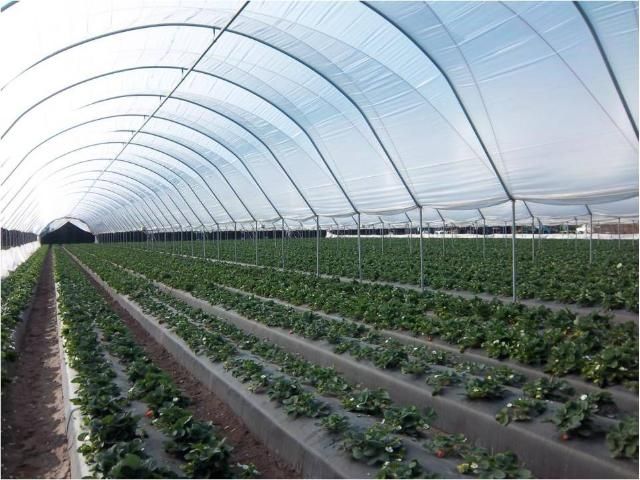
Credit: UF/IFAS
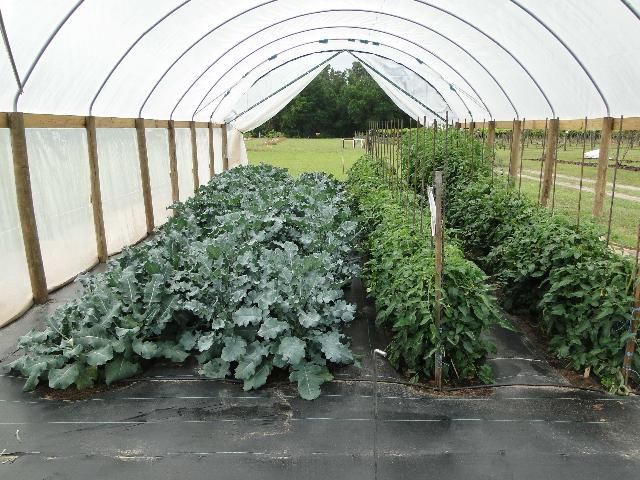
Credit: UF/IFAS
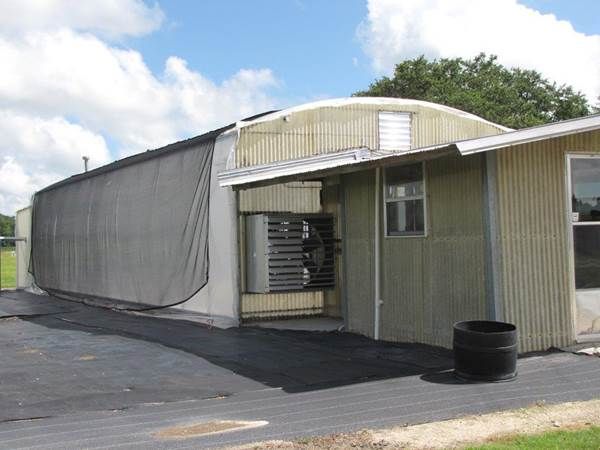
Credit: UF/IFAS
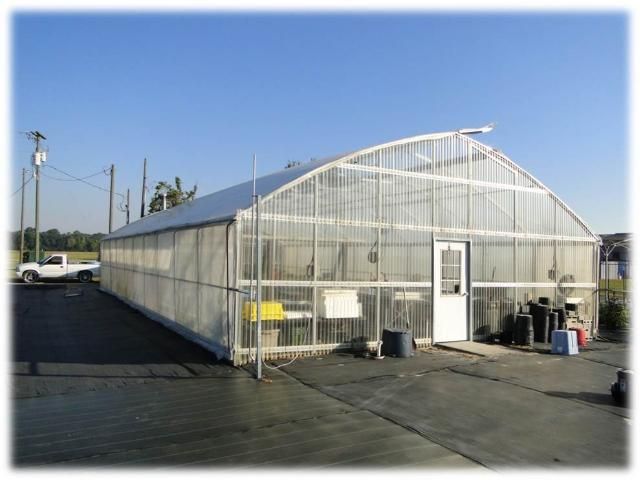
Credit: UF/IFAS
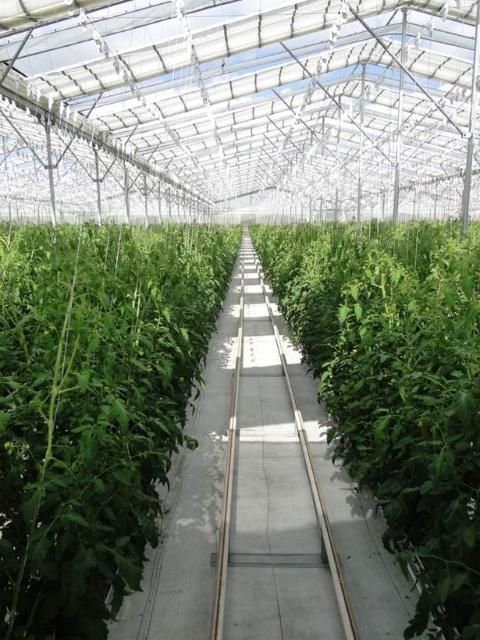
Credit: UF/IFAS
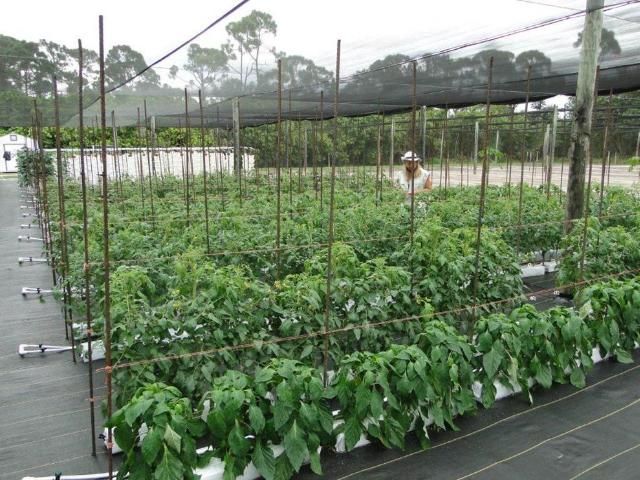
Credit: UF/IFAS
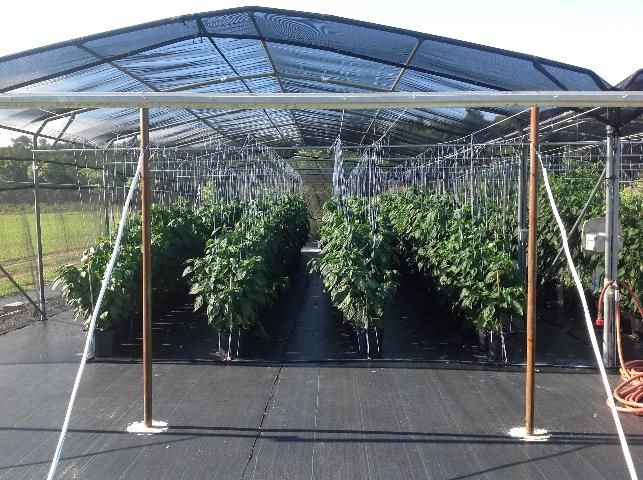
Credit: UF/IFAS
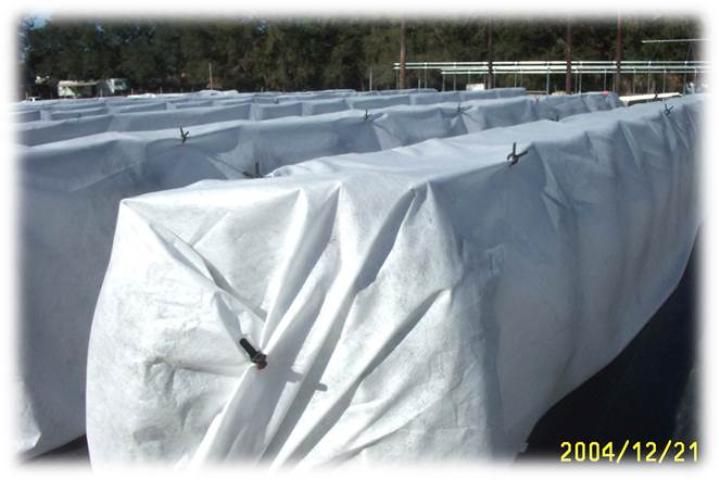
Credit: UF/IFAS
Crops
The 2013 survey documents the high level of crop diversification that has evolved in protected agriculture in Florida since 2001. Crops that were popular in protected agriculture in the decade from 1991 to 2001 are still popular today. Those crops include tomato, pepper, lettuce, cucumber, and basil. However, the survey results show significantly higher acreage of blueberry, strawberry, microgreens, specialty leafy greens, herbs other than basil, and specialty root crops (beets, radish, and carrot). The crop category results also showed the difference in crop choices between large and smaller operations using some type of structure (high tunnels, greenhouses, or shade houses). The larger operations (Figure 9) tended to grow a single crop, or at least not more than two or three crops. The large operations (more than 3 acres) were growing blueberry, strawberry, tomato, colored bell pepper, or cucumber and were selling mostly to wholesale chains or distributors. Small-to medium-sized operations (0.1 to 3 acres) were much more likely to grow several crops and depended more on direct market sales (on-farm sales, farmers markets, farm to school, subscription sales, restaurants, or local stores).
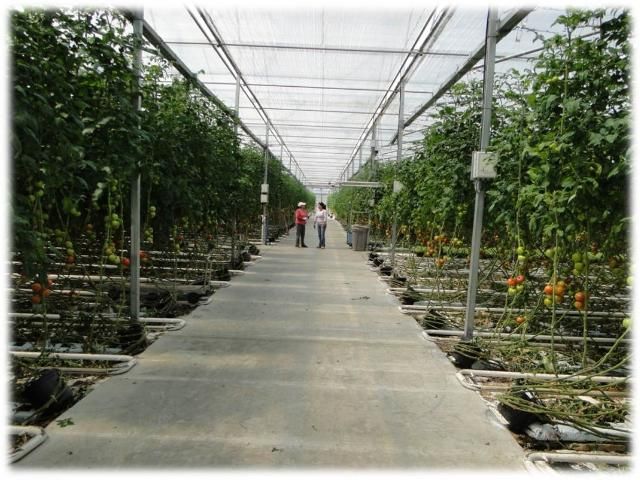
Credit: UF/IFAS
Soil Culture and Soilless Media
The variety of soil or soilless media choices being used was as diverse as the crop mix in 2013 Table 2. The largest acreage category was native soil or amended native soil, with 164.18 acres. Large blueberry acreage under high tunnels (Figure 10) were typically grown in a pine bark amended native soil or a raised pine bark bed (Santos and Salame-Donoso 2013). Much of the field strawberry acreage under tunnel was grown in native soil using the standard plastic mulched bed system (Santos Salame-Donoso et al. 2013). Other crops grown in native soil under high tunnels included tomato, basil and other herbs, and mixed vegetables.
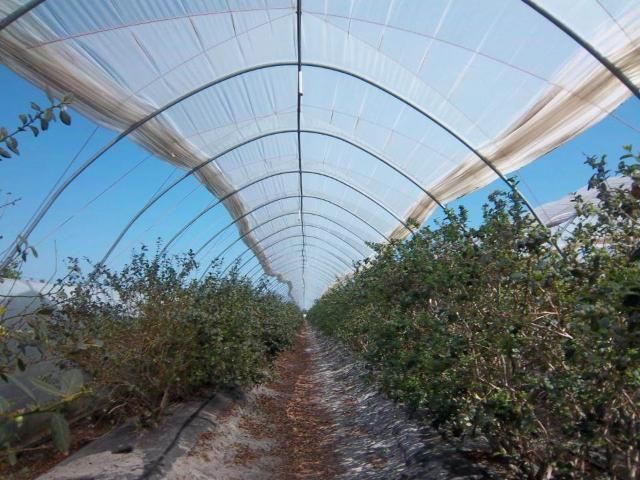
Credit: UF/IFAS
Soilless media choices included single-product materials as well as a variety of product mixes. The most common single soilless media materials were coconut fiber, composted pine bark, and perlite. Soilless mixes were quite varied, with combinations including two or more of the following materials: coconut fiber, peat, perlite, composted pine bark, and vermiculite. Soilless media systems included the following acreage: lay-flat bags (7.81 acres, Figure 11), upright containers (63.96 acres, Figure, 12 and 13), and open trough (12.28 acres, Figure 14). In some hydroponic systems, only a liquid culture was used. These systems primarily included NFT (5.64 acres, Figure 15) and floating systems (1.75 acres). An additional 16.55 acres of space utilized other types of production systems not in the above categories, including microgreen trays (Figure 16) and recirculating systems, ebb and flow, and other miscellaneous or undescribed systems.

Credit: UF/IFAS

Credit: UF/IFAS
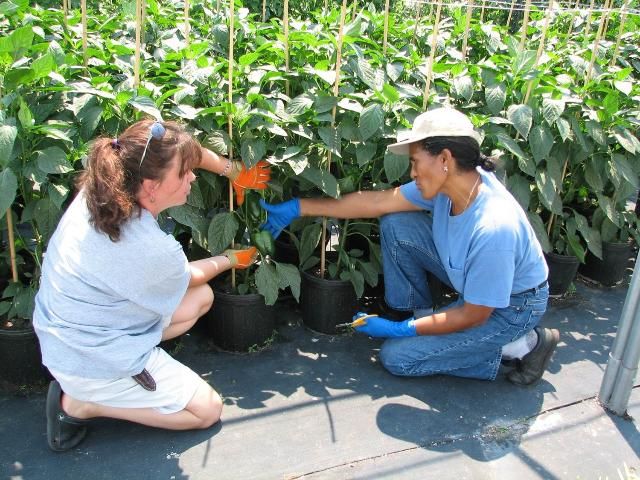
Credit: UF/IFAS

Credit: UF/IFAS
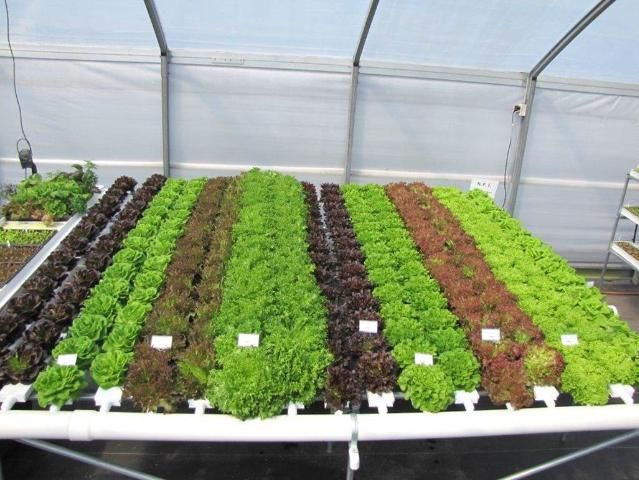
Credit: UF/IFAS

Credit: UF/IFAS
Vertical Production Systems
One other unique aspect of the survey results was the recent establishment and expansion of vertical hydroponic systems. These systems generally use polystyrene stacking pots/containers and are used to form individual towers (Figure 17). The towers may have 4 to 8 pots per tower, depending on the crop to be grown, and may also have one bottom or ground level pot to absorb leachate and still grow a crop. The challenge in summarizing the survey data was how to report these vertical system farms. For this survey, the acreage of vertical culture reported (113.60 acres) is the actual geographical space (farm footprint) occupying the system. However, the actual plant population used in these vertical systems is much higher than traditional ground level culture. It is very common to have plant populations 4 to 5 times higher per farm footprint than one would have in traditional ground-level culture. Therefore, the acreage reported in Table 2 for vertical systems, 113.60 acres, may actually represent much more active crop production space. In either case, the data show that vertical hydroponic systems represent a very important component of the overall protected agriculture and hydroponic industry in Florida.
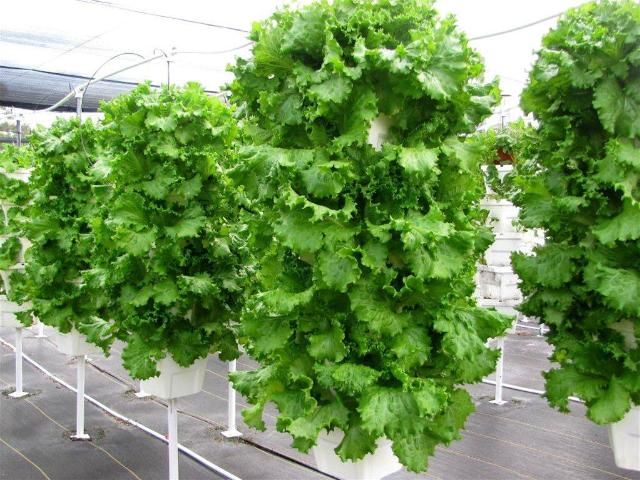
Credit: UF/IFAS
Other information collected in the survey, but not reported here, indicated that many respondents were planning to expand or were satisfied at their current size. Those operations not planning to expand or even planning to decrease in size often listed challenges in marketing, access to labor, and time commitment as reasons for their concerns. Pest management was listed as a challenge as well, with the most commonly mentioned pests including silverleaf whitefly, aphids, thrips, broad mites, and spider mites. Very few operations indicated they were using biological control strategies. This may be an area for further research and Extension efforts in the future.
The actual value of this diverse and emerging industry in Florida is difficult to estimate. However, we have calculated an estimate based on conservative yield and value of the crops currently being grown. A greenhouse tomato crop with a conservative yield of 20 pounds per plant per season and a population of 10,000 plants per acre would result in 200,000 lbs. per acre. A modest value of $1.25 per pound of tomato would result in estimated gross sales of $250,000 per acre. Other personal interviews with existing small farms operating on a shorter seasonal basis with other crops give a conservative estimate of gross sales at $100,000 per acre per year. Using these ranges in gross sales, the protected agriculture fruit and vegetable industry value in Florida is estimated to be at least $50,000,000, and more likely nearly $100,000,000 per year. This estimated value does not include the secondary impact of sales from the allied industry supporting Florida operations.
For additional reading on many of the topics covered in this document on protected agriculture and hydroponic production systems, see https://smallfarm.ifas.ufl.edu/production/hydroponics, http://www.hos.ufl.edu/protectedag/index.htm, or https://edis.ifas.ufl.edu.
Literature Cited
FDACS (Florida Department of Agriculture and Consumer Services). 2014. Florida Agriculture Overview and Statistics. 15 Jan. 2014. https://www.fdacs.gov/Agriculture-Industry/Florida-Agriculture-Overview-and-Statistics.
Fenneman, Daniel K., Robert C. Hochmuth, Wanda L. Laughlin, and Sean R. McCoy. 2013. Veggies and Herbs Made in the Shade: A Growing Season Calendar for North Florida. HS1228. Gainesville: University of Florida Institute of Food and Agricultural Sciences. https://edis.ifas.ufl.edu/hs1228.
Hochmuth, G. J. 2012. Introduction- Florida greenhouse Vegetable Production Handbook, Vol. 1. HS766. Gainesville: University of Florida Institute of Food and Agricultural Sciences. https://edis.ifas.ufl.edu/cv244.
Hochmuth, G. J., R. C. Hochmuth, W. D. Thomas, and M. S. Sweat. 2012. Crop Production - Florida Greenhouse Vegetable Production Handbook, Vol. 1. HS769. Gainesville: University of Florida Institute of Food and Agricultural Sciences. https://edis.ifas.ufl.edu/cv247.
Hochmuth, George and Robert Hochmuth. 2012. Open-Field Soilless Culture of Vegetables. SL291. Gainesville: University of Florida Institute of Food and Agricultural Sciences. https://edis.ifas.ufl.edu/ss504.
Hochmuth, George J., and Robert C. Hochmuth. 2014. Greenhouse Manufacturers and Suppliers. HS1020. Gainesville: University of Florida Institute of Food and Agricultural Sciences. https://edis.ifas.ufl.edu/hs255.
Hochmuth, George J., Robert C. Hochmuth, Steve Kostewicz, and William Stall. 2012b. Row Covers for Commercial Vegetable Culture in Florida. Circular 728. Gainesville: University of Florida Institute of Food and Agricultural Sciences. https://edis.ifas.ufl.edu/cv201.
Hochmuth, R. and D. Cantliffe. 2012. Alternative Greenhouse Crops- Florida Greenhouse Production Handbook, Vol. 3. HS791. Gainesville: University of Florida Institute of Food and Agricultural Sciences. https://edis.ifas.ufl.edu/cv272.
Hochmuth, Robert C., Danielle D. Treadwell, Eric H. Simonne, Linda B. Landrum, Wanda L. Laughlin, and Lei Lani Davis. 2013. Growing Bell Peppers in Soilless Culture under Open Shade Structures. HS1113. Gainesville: University of Florida Institute of Food and Agricultural Sciences. https://edis.ifas.ufl.edu/hs368.
Santos, Bielinski M. and Teresa P. Salame-Donoso. 2013. Protected Culture for Vegetable and Small Fruit Crops: Southern Highbush Blueberry Cultivars under High Tunnels. HS1226. Gainesville: University of Florida Institute of Food and Agricultural Sciences. https://edis.ifas.ufl.edu/hs1226.
Santos, Bielinski M., Teresa P. Salamé-Donoso, Craig K. Chandler, and Steven A. Sargent. 2013b. Protected Culture for Vegetable and Small Fruit Crops: High Tunnels for Strawberry Production in Florida. HS407. Gainesville: University of Florida Institute of Food and Agricultural Sciences. https://edis.ifas.ufl.edu/hs407.
Santos, Bielinski M., Gary Vallad, and Emmanuel A. Torres-Quezada. 2013a. Protected Culture for Vegetable and Small Fruit Crops: Types of Structures. HS1224. Gainesville: University of Florida Institute of Food and Agricultural Sciences. https://edis.ifas.ufl.edu/hs1224.
Tyson, R., R. Hochmuth, and D. J. Cantliffe. 2013. Hydroponic Vegetable Production in Florida. HS405. Gainesville: University of Florida Institute of Food and Agricultural Sciences. https://edis.ifas.ufl.edu/hs405.
Tables
Acreage of fresh fruit and vegetable crops grown with various types of protected agriculture structures.